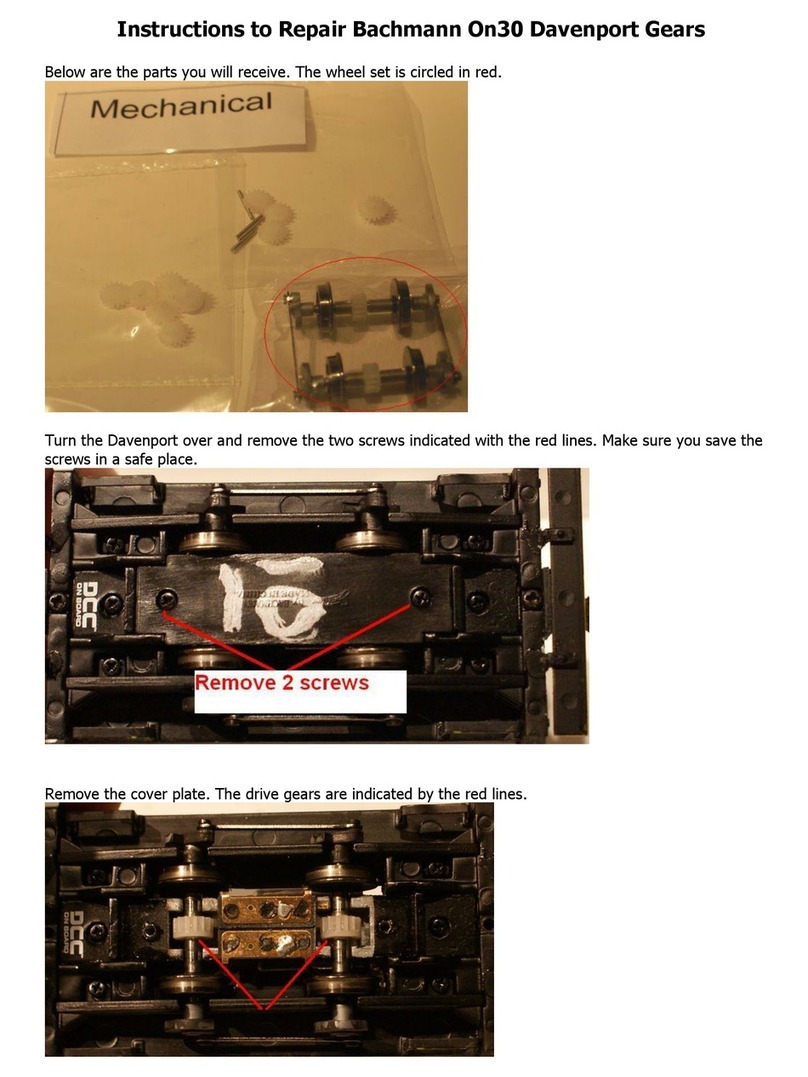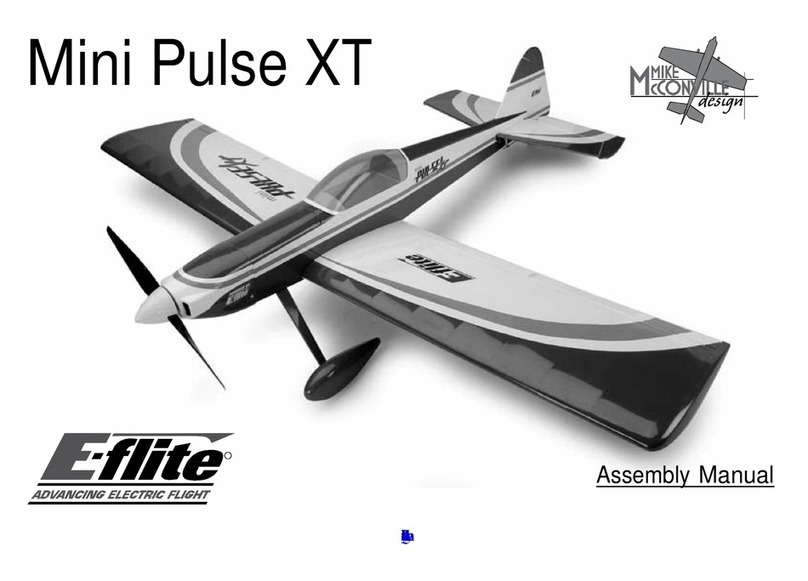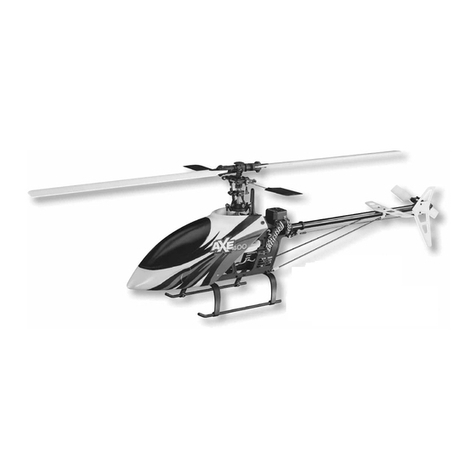FlyingBalsa MKII Humpback User manual

MKII 'Humpback'
Instruction Book
Initial release (May 2012)
Motor
Size
Eflite Power 25 or
Power 32
Rotor
Diameter 43”
ength
overall 36”
Weight 54 oz.
Head FlyingBalsa Gen III
Rotor
Airfoil
Aerobalsa high
performance SG6042
4 Channel
Direct rotor control
Pitch / Roll, Throttle
and Rudder
The MKII is a CAD designed, CNC manufactured auto gyro sport flier.
The MKII is designed to be a very stable, forgiving auto gyro with great performance. It was designed and tested
to be capable of flying in winds up to 15 mph and to ROG (rotate off ground) for takeoff's. No hand launches
are needed with the MKII.
By using CNC equipment, design tolerances are very tight and performance is duplicated kit to kit.
We recommend seeking help from the local modelers in your area if you are inexperienced. Orientation could be
your toughest challenge.
We hope you enjoy the MKII as much as we do.
Warranty
FlyingBalsa, C guarantees this kit to be free of defects in both material and
workmanship at the date of purchase. This warranty does not cover any damage of
component parts by modification, use or shipping. In no case shall FlyingBalsa, C
liability exceed the original cost of the kit. Further, FlyingBalsa, C reserves the right
to change this warranty without notice.
In that FlyingBalsa, C has no control over the final assembly or material used for
final assembly, no liability shall be assumed or accepted for any damage resulting from
the use by the user of the final user assembled product.

Table of contents
Table of contents..................................... xx
ist of CNC machined parts................... 1
Kit Contents............................................. , 3
Suggested supplies and tools................... 3
Recommended equipment....................... 3
Building................................................... 4
Horizontal stabilizer.................... 4
Vertical stabilizer........................ 4
Fuselage....................................... 5, 6, 7, 8, 9, 10, 11
Pylon............................................ 1 , 13
Tail installation............................ 14
Tail wheel, rudder, main gear...... 15
Radio installation......................... 16
Motor installation......................... 17
Control surface rigging................. 17
Rotor head installation................. 18
Rotor blade construction.............. 18
Blade balancing............................ 19
Initial setup................................... 19
Preflight........................................ 19
Flying............................................ 0
Contact information..................... 1
Revision history........................... 1
xx

PartsKit Cut
CNCMKII
Pylon Sides
L.G. Block
Firewall
Rotor Blade
Rotor Blade
Rotor Blade
** T ese parts are included in t e gimbal kit
Lower Gimbal **
Retainer **
Control Arm **
Upper Gimbal **
Doubler
Doubler
Fin
Elevator
Elevator
Horizontal stabilizer
Rudder
Fuselage filler plug
Battery Hatc
Pylon Hatc
F-2 F-1
Tongue
Wire Trap
Pylon Core
Pylon Support
Tail W eel Mount
Hatc Supports
Pylon Sides
Pylon Spacers
Blade Reinforcements
Fuselage Side
Fuselage Side
Pylon Forks
Rudder servo mount
* T ese parts are include in t e ead kit
Bearing Retainers*
Head Card*
Head Hinge*

Kit Contents
Documentation:
6 sheets 11” x 17” CAD drawings
1 Instruction book
Blades:
3 each Aerobalsa high performance SG6042 CNC machined for blade bolt bushings and to fit the FlyingBalsa
Generation III rotor head.
CNC parts:
See page 1
Hardware Bag:
1..... rudder horn with 2 screws
2..... main landing gear securing straps with 4 screws
1..... 3/32 x 1 gimbal pivot wire
2..... 3/32 wheel collars for gimbal pivot wire
2..... 4-40 swivel ball links
3..... rudder hinge strips
2..... landing gear hardwood torque blocks
1..... Du-Bro 1/16” nylon wire keeper for rudder pushrod
1..... Du-Bro 1/16” EZ connector for rudder pushrod
2..... Du-Bro 4-40 EZ connectors
6..... 8-32 nylon screws
3..... 4-40 x 3/4 socket head blade bolts
3..... 4-40 self locking nuts
3..... nylon rotor blade bushings
3..... #4 flat washers for blade bolts
2..... #6 flat washers for main landing gear wire
2..... 5/32 wheel collars for main wheels
1..... .050” Allen wrench for 3/32” and 1/8” wheel collars
1..... 1/16” Allen wrench for 5/32” wheel collars
1..... #33 drill bit to ream holes for 4-40 screws
1..... #43 drill bit to ream holes for 2-56 screws
1..... 1/16” drill bit for main landing gear and tail wheel bracket
2..... #2 x 5/8” (or 1/2”) screws to secure the tail wheel bracket
Wood bag:
1..... plywood firewall/landing gear mount
2..... balsa pylon sides
1..... 1/8 x 1/8 x 4 balsa strip
1..... 1/8 x 1 x 4 balsa for forward fuselage filler
1..... 3/32” plywood pylon fork card
1..... 3/32” plywood rudder servo mount
2..... balsa fork spacers
1..... toothpick
1..... 1/16 x 7” rudder pushrod wire
1..... 1/8 x 2-1/4” wood dowel for pylon forks

Other included items:
1..... 1/8 x 4 x 36 balsa for fuselage sheeting
1..... 3/8 x 3/8 x 12 balsa triangle for firewall and pylon reinforcement
1..... Generation III head kit
1..... Generation III gimbal kit
1..... Du-Bro tail wheel bracket
2..... 4-40 x 12 threaded push rods for pitch and roll
1..... pair pre-bent main landing gear
2..... 3” Du-Bro main landing gear wheels
1..... 1” tail wheel
End of kit contents
Suggested Supplies and Tools
In addition to the normal modelers tools we recommend the following:
Square................ for squaring formers and general usage.
3/32 drill bit........ for reaming gimbal pivot hole.
5/32 drill bit........ for drilling the landing gear torque blocks.
#29 drill bit......... for 8-32 tap.
8-32 tap............... for pylon and tank hatch screws.
End of suggested supplies and tools
Recommended Equipment
Motor – Eflite Power 25 or Power 32
Servos - Hitec HS 225MG for pitch and roll, Hitec Hs 85 for rudder control
Receiver – Spektrum AR6210 used in prototypes
Battery – Gen Ace 3S 4000 mah i-Po used in prototypes
ESC- Castle Creations Thunderbird 54 used in prototypes
Prop – APC Thin electric 13 x 8.5
Covering - Ultracote
3

General construction notes:
The CNC cut parts will have small 'tabs' on them when they are removed from their sheets. The tabs must be
removed prior to use. Use care and do not sand or cut into the part while removing the tabs. The term “use thin
CA glue” refers to thin 'cyanoacrylate' glue. For the epoxy glued parts we recommend using 15 epoxy. 5 minute
epoxy will not give you enough time when gluing on the fuselage doublers. For sanding balsa parts, a 'fine' grit
of paper is all you need.
Gimbal and Head assemblies:
The gimbal and head assemblies are self contained separate 'mini kits' and are included with the MKII. These
can be built at the same time the basic model is being built. No further instructions for the head and gimbal will
be noted in this manual. Follow the instructions included with the gimbal and head kits. You will need these
items starting at step 42 in this manual.
Horizontal Stabilizer:
1) ocate the horizontal stabilizer and elevators.
Assemble the horizontal stabilizer assembly on a
flat surface. Simply glue the elevators to the
horizontal stabilizer as shown in this photo. Use
thin CA glue. The “elevators” are fixed and do
not move on this model. Sand the horizontal tail
assembly for film covering.
Vertical Stabilizer:
) The vertical fin and the rudder can now be sanded smooth for covering.
Round off the leading edge of the rudder and the rear edge of the fin. The
hinge slots will be cut AFTER both pieces are covered. This will be explained
in detail during 'final assembly'.
Fuselage:
This section covers the construction of the fuselage assembly. Take your time and ensure that the fuselage is
straight and square. We have engineered into the MK II many features that will help you assemble a straight
airframe.
****************************************************************************
Tech note : Before gluing the doublers, ensure that you are building a left and a right side, since the fuselage
sides and the doublers are identical it is possible to build two rights or lefts.
Use the tabs on F1 and F2 as alignment aid to properly locate the doubler on each fuselage side. Do not glue the
formers in place yet. When the doubler is in the correct position, remove F1 and F2 and allow the epoxy
securing the doubler to cure. Ensure the doubler does not move out of position!
****************************************************************************
4

3) ocate the two 3/16 balsa fuselage sides, the
1/16 plywood fuselage doublers, and formers F1
and F2. Start by gluing the doublers to the
fuselage sides using 15 minute epoxy glue. Center
the doublers vertically on the balsa sides. You may
notice that the doublers are approximately 1/64”
narrower than the balsa sides on the top and
bottom of the doubler. This is normal. You can
use one of the lite-ply formers to align the slots of
the doubler to the slots in the sides but DO NOT glue any formers in place yet! Also notice that the doubler does
not go all the way to the forward edge of the fuselage side. This was purposely designed this way to
automatically align the firewall in a later step.
4) Decide which side of the fuselage you want the
rudder servo to be on. It does not matter but on the
prototype it is installed on the left side. Remove
the servo filler plug from the tail card sheet and
glue it into the servo cut out hole on the side you
DO NOT want the servo to be on. Use thin 'CA'
glue. You will need to just barely round off the
four corners of the plug.
5) Epoxy the rudder servo mount in place on the
inside of the other fuselage side (the same side the
fuselage doubler is on). Simply align the
horizontal edges of the mount with the horizontal
edges of the cut out in the fuselage side. Ensure
the 2 holes for the servo mounting ears are
centered, fore and aft, in the fuselage cut out when
viewed from the outside of the fuselage side ( i.e.
the other side of what is shown in this photo). You
do not want the servo mounting holes to be
covered up by the balsa sides. NOTE: see step 37
on page 15 for a picture of what this looks like from the 'outside'.
6) ocate lite-ply formers F-1 and F-2 and the birch plywood lower pylon
support and dry assemble the former cage as shown in the photo. DO NOT glue
any of these parts together!
5

7) Install the former cage on the inboard side of one of the
completed fuselage sides. The inboard side is the doubler
side. Ensure the pylon support is towards the bottom of
the fuselage. Before gluing the formers in place, ensure
the former tabs are fully seated in the slots and use a
square to ensure that F1 and F2 are perpendicular to the
fuselage side. Use thin 'CA' glue. Do not glue the pylon
support yet.
8) The other fuselage side is glued on next. Align the
former cage on top of the remaining side and ensure the
former tabs are fully seated in the slots. Before gluing
with thin 'CA' glue make sure the fuselage is square in all
directions. Do not glue the lower pylon support in place
yet.
9) The 1/4” plywood firewall is glued in place using 15
minute epoxy. Be sure to keep the fuselage assembly
square while the glue cures. Note that it fits into the space
formed where the plywood doublers end. Align the
firewall with the top of the fuselage sides. It will extend
slightly below the bottom of the fuselage and will be
sanded flush with the landing gear mount in a later step.
When the firewall glue has cured, epoxy the 1/4” plywood
landing gear mount in place. Note that it fits into the
notches cut out of the 1/16” plywood doublers. When the
epoxy cures for the firewall and landing gear mount, sand
off any 'squeezed out' epoxy and the lower edge of the firewall flush with the landing gear mount so that the
1/8” lite-ply wire trap will lie flush with the sides. Note that this picture shows both the firewall and landing
gear mount glued in place. It is recommended that each piece be glued in place separately, firewall first then the
landing gear mount. IMPORTANT NOTE: see step 24 on page 12 before gluing the firewall in place. It will be
easier to drill the air cooling inlet holes in the firewall before it is glued in place.
6

10) The three 1/8” birch plywood hatch mounts are glued
in place with 15 minute epoxy. The mounts fit into the
notches of the fuselage doublers. Install each mount as
shown in this photo and ensure they are flush or slightly
below the top of the fuselage sides. They must NOT
extend above the sides or the formers!
11) Cut the 1/8” square balsa piece to length and glue in
place behind F-2 at the top of the former. Use thin 'CA'
glue. This piece will give support to the 1/8” balsa upper
fuselage sheeting which will be installed in a later step.
Now the lower pylon support can be secured with thin
'CA' glue.
1 ) The 1/8” lite-ply wire trap is glued in place with 15
minute epoxy. It is important to ensure the wire trap is
'square' to the fuselage since this will set the main landing
gear alignment. It fits even with the front of the firewall.
Note that the wire trap extends past each side an equal
amount. These 'extensions' will be sanded off flush with
the sides in a later step resulting in a perfectly spaced gap
for the main landing gear wires.
7

13) The landing gear torque blocks and 3/8” balsa triangle
braces are installed next with 15 minute epoxy. This can
all be accomplished at the same time. The torque blocks
have a angle sanded in them to match the firewall down
thrust. et the triangle pieces extend slightly above the
firewall. They will be sanded flush with the firewall when
the glue cures.
NOTE: cut two each 2” long pieces from the balsa
triangle for the firewall braces. The remaining piece will
be used for the pylon support.
****************************************************************************
Tech note: Draw a straight line on your building board approximately 36 inches long. This line will be used
to align the notches in the bottom of the firewall, F1, F2 and the rear end of the fuselage sides to help ensure a
straight airframe.
****************************************************************************
Take your time with this step and build carefully. This is critical to a straight fuselage!
14) Place the completed fuselage sub assembly on the line you drew on your building board. Ensure that the
small notch on the bottom of the firewall and formers F-1 and F-2 are directly over the drawn line. You will
need to secure the fuselage so that it does not move off of the line. Heavy weights placed along each side of the
fuselage work well. Also ensure that the fuselage stays firmly on top of the building board. Do not let it rise or
twist off of the surface. Now carefully bring the two fuselage sides together and meet them directly over the
drawn line. Be sure to use one or two small 'squares' at the rear end of the fuselage before the sides are glued
together! Otherwise it would be very easy to build a twist into the aft section of the fuselage resulting in a 'tilted'
tail section.
15) Remove the tail wheel mount bracket from the 1/8” birch plywood
card. Glue it to the rear of the fuselage on the bottom side with 15
minute epoxy. Note that it is slightly oversize to allow for final sanding
to fit the fuselage.
8

16) Next you will be sheeting the bottom of the fuselage. All sheeting, top and bottom is installed cross-grain.
ocate the provided 1/8” x 4” x 36” balsa sheeting. Sheet bottom of the fuselage from the aft side of the wire
trap to the forward edge of the tail wheel bracket mount. Carefully mark and cut the 1/8” balsa sheeting as there
is just enough raw material to sheet the fuselage top and bottom with no scrap left over. Use thin CA glue to
attach the sheeting to the sides and be sure to glue each cross grain seam too.
17) Slightly round off the edges of the lower
straight portion of the plywood pylon core where
it passes through the pylon hatch. Do not round off
the egdes of the upper curved portion of the pylon
core. Carefully push the pylon core through the
slot of the pylon hatch. BE CAREFU ! The lite-
ply hatch is easily broken at this stage of building.
Insert the pylon core through the slot of the lower
pylon support and fully seat the pylon core on the
fuselage floor. Move the pylon core/hatch
aseembly as needed to center the hatch between
the formers and the fuselage sides. When
everything is in proper alignment, drill through one of the four hatch pilot holes and 1/8” birch plywood hatch
mount with a #29 drill bit. Be sure to drill straight and perpendicular to the hatch. Remove the pylon/hatch and
then tap that one hole for the 8-32 nylon screw. Ream that same hatch hole with a #18 drill bit for a clearance of
the 8-32 nylon screw. Reinstall the pylon/hatch assembly and secure with a 8-32 nylon screw in the hole you
just tapped. Repeat the drill and tap operation on the opposite, diagonal corner of the hatch. Then repeat once
again on the remaining two hatch hold down screws. This method of drilling and tapping each hole individually
takes more time but the resulting fit of the hatch to the fuselage will be superior than if you try to drill and tap
all four holes at the same time. Do not glue the pylon core to the pylon hatch at this time!
18) The top of the fuselage can now be sheeted. You will
need the remaining piece of 1/8” x 4” balsa from the
bottom sheeting. Install the pylon hatch with four nylon
screws. The pylon core does not need to be installed for
this step. Trim a piece of 1/8” balsa sheeting to fit behind
the pylon hatch. Before gluing the first piece of balsa
sheeting in place, it is best to leave a small gap between
the sheeting and the pylon hatch. This allows room for the
film covering to 'fill' the gap when the model is covered.
The easiest way to produce the correct gap is to fold a
small piece of printer paper in half (i.e a piece of this
manual) and then fold in half again so that you have four
thickness' of paper and place it between the hatch and the sheeting. Spot glue the first piece of balsa sheeting in
place with thin CA glue being careful not to glue either the paper or pylon hatch to the model. Remove the
paper and pylon hatch and fully secure the first piece of sheeting in place.
9

19) Continue sheeting the top of the
fuselage stopping at the point where the
horizontal tail will go. Remember, there
is enough sheeting supplied with the kit
to sheet the top and bottom of the
fuselage but you cannot be wasteful
with the wood. Once the upper sheeting
is all glued on, reinstall the pylon hatch
with the nylon screws for the next step.
0) Using a #43 drill bit ream the two holes of the hatch tongue
and two of the holes at one end of the tank hatch. Break the
toothpick in half. Glue the hatch tongue to the hatch using the
toothpick halves through the reamed holes as an alignment aid.
Trim toothpicks and sand smooth on both sides.
1) Position the tank hatch on the fuselage with a small gap
between the tank and pylon hatches using the method when you
sheeted the upper fuselage. Note: there will be about a one inch
gap at the front of the hatch. This is normal. Carefully mark
the two screw positions for the tank hatch. It is recommended
that you drill and tap each hole one at a time the same as was
done for the pylon hatch. Remove the hatch then drill and tap the
plywood mount for the 8-32 nylon hold down screws (#29 drill
bit). Ream the two screw holes in the tank hatch for a slip fit of
the the 8-32 screws (#18 drill bit) and then screw the hatch in
place for the next step.
) The forward fuselage filler piece is the 1/8 x 1-1/2 x 4 balsa
piece in the wood bag. Simply glue it to the top of the forward
end of the fuselage (at the firewall) with a gap between it and the
tank hatch. Use the folded paper as before. Caution: Do not glue
F3 to the tank hatch tongue! Glue to the fuselage sides and
firewall only! It is intentionally oversize so it can be sanded
flush with the fuselage sides and firewall.
With both hatches installed, the fuselage can now be sanded
smooth for covering. Note that you will sand off the excess
material from F-3, the wire trap, and the 1/8” balsa top and
bottom sheeting. Round all edges to approximately 1/8” radius.
10

3) Drill a hole at each end of the landing gear
mount for the preformed landing gear. Use a #21
drill bit. ocation is critical. See the CAD
drawings for locations. Note that the holes are
staggered! Drill the holes perpendicular to the
fuselage bottom. For example, if you have a large
enough drill press table, place the pylon hatch
section of the fuselage on the drill press table.
This will automatically set the desired
perpendicular angle of the main landing gear wire.
After the holes are drilled cut a relief radius into
the gear mount to match the bend in the main gear
wire. This can be accomplished using a #21 drill
bit in a battery powered drill.
4) Cut a hole for the motor wires approximately
1/2” in diameter just aft of the landing gear mount.
Also cut a battery cooling vent approximately 3/4”
wide and 2-1/4” long just forward of F-2 on the
belly fuselage sheeting. If you are converting to
glow engine these holes do not need to be cut.
5) Drill two air inlet holes in the firewall for battery and ESC
cooling. The size and location will be determined by size and
shape of the electric motor mount you use. The prototype used
5/8” diameter holes drill with a 'spade' drill bit used for wood
work. It will be much easier to drill the holes on a drill press
BEFORE the firewall is glued in place.
These cooling inlet holes are not required if converting to use a
glow engine.
11

This completes the basic fuselage structure.
Pylon Assembly:
6) You will need the parts shown in this photo: The pylon
core, 2 each pylon forks, pylon spacers, pylon sides and the 1/8
birch dowel. The dowel will need to be cut in half and then both
of those pieces cut in half again so that you have 4 equal length
pieces. NOTE: the servo cutouts are made for Hitec HS-225mg
servos. If you are not going to use those servos, now would be
the time to 'make adjustments' to the pylon core. It is highly
recommended to stay with the 225mg servos.....
7) Temporarily align each fork with the 4 holes and mark on the INSIDE
surface of the forks along the top of the pylon core. This is simply a reference
mark on where to apply the epoxy glue. The entire 'fork' assembly can be done in
one setting using 15 minute epoxy glue. The holes for the 1/8” dowel fork pins
are all pre-drilled. Apply epoxy to the inside surface of both balsa fork spacers
and align them with the 4 holes. Push a 1/8” dowel piece through each of the 4
holes with an equal amount extending out on both sides of the pylon. Coat the
inside surfaces of both forks with epoxy up to the mark you previously made.
Also apply some epoxy to the 4 dowel pins. Align the forks to the pins and slide
onto the dowels. It is a good idea to clamp the assembly together while the glue
cures. After the glue cures the dowel pins can be sanded flush with the forks.
The picture shows how it should look when finished.
NOTE: The pylon spacers are very slightly oversize to allow for sanding to
perfectly match the plywood forks.
1

8) The pylon sides are simply glued to the pylon core using epoxy glue (one on each
side of the core). To ensure the best fit, slide the pylon core into the pylon hatch and
then screw the hatch to the fuselage. Make sure the pylon core is fully seated on the
fuselage lower sheeting. Also make sure the lite-ply hatch is 'flat'. It is possible for the
hatch to become slightly bowed or 'pushed down' because of the tight fit of the pylon
core passing through the slot. Test fit the pylon sides to the core. The sides should be
tight against the bottom of the forks and no gap at the bottom where it meets the hatch.
If there is a gap, simply sand a tiny amount off the bottom of the pylon core but this
should not be necessary. When satisfied with the fit, glue the sides in place with epoxy
glue. Clamp the sides together while the glue cures. The picture shows the finished
pylon assembly ready for sanding.
9) Now it's time to complete the pylon assembly. First you will
need to cover the pylon hatch and pylon assembly separately. The
inside of the forks can be finished with film covering but you will
need the special Monokote type of 'trim tool' to accomplish this.
Another option would be to simply paint the inside surface of the
forks. eave the bottom end of the pylon sides uncovered. Also
cut away a small piece of covering along the slot of the pylon
hatch but not longer or wider than the pylon assembly. This is for
a wood to wood contact for the next step.
30) Slide the pylon core through the slot in the pylon hatch one last time.
Ensure the hatch is in full contact with the bottom of the pylon sides.
Insert the pylon into the fuselage and then secure the hatch in place with
the the nylon screws. When you are satisfied with the alignment, tack
glue the pylon to the pylon hatch with thin CA glue. Be careful when
using CA glue on film covering because the glue can 'run' and cause
'fogging' on the covering. Use just enough glue to secure the pylon to the
hatch. The purpose of the thin CA glue is not for structural strength but
rather alignment purposes. Carefully remove the pylon/hatch assembly
from the fuselage and epoxy two pieces of 3/8” balsa triangle stock to
the inside of the pylon hatch where the pylon goes through the slot. The
pylon to hatch joint is another important structural joint.
This completes the pylon assembly.
13

31) Cover the fuselage, horizontal stabilizer,
vertical fin and rudder, and battery hatch
with your favorite film covering. Ultracote
was used on the prototype.
3 ) Using a #11 X-acto knife or equivalent, cut two rudder hinge slots in
the vertical fin approximately 1/2” down from the top of the fin and up
1/2” from the bottom of the fin. Now cut two matching slots in the
rudder. Also cut a third slot (not shown in the photo) in the rudder 1-3/8”
up from the bottom of the rudder. This hinge will go into the upper part
of the fuselage tail post just under the horizontal stabilizer. Do not glue
any hinges in place yet. Separate the fin and rudder.
33) Test fit the horizontal stabilizer to the fuselage
and carefully remove the film covering from the
stabilizer bottom where it gets glued to the
fuselage. Glue the vertical fin to the horizontal
stabilizer using thin CA glue. Be sure to retain a
balsa to balsa joint on the tab and slot area of the
tail pieces. Use a small square to ensure the fin is
perpendicular to the stabilizer.
34) Carefully align the tail assembly to the fuselage making sure it is
straight and square both vertically and horizontally. Temporarily secure
it in place with a combination of T-pins and rubber bands. When
satisfied with the fit, glue the horizontal stabilizer to the fuselage with
thin CA glue. Use care when using thin CA glue to secure the tail
assembly to the fuselage. The glue can 'run' and make a mess of things.
14

35) The tail wheel bracket assembly is attached to the fuselage with two #2 self
tapping screws which are supplied in the hardware bag. Hold the tail wheel
assembly in place with the wire firmly touching the rear end of the fuselage.
Mark the location of the two screw holes and drill with a 1/16” drill bit. Simply
attach the bracket with the two screws. NOTE: detailed instructions on how to
build the tail wheel bracket is shown on sheet 2 of the CAD drawings.
36) Cut a slot in the upper rear fuselage post to match the third rudder hinge
location. Very carefully and accurately mark the location of the tail wheel
wire where it will go into the rudder. Drill a hole for the wire into the rudder
using a 1/16” drill bit. Using a heavy gauge T-pin works great for 'pilot'
drilling the hole. Be sure to drill straight into the rudder both vertically and
horizontally. There is no need to under cut or inset the tail wheel wire into
the rudder. Insert the three rudder hinges into the slots of the rudder. There is
no easy way to accomplish the next step. You will just have to work
methodically and carefully in order to get the three hinges and the tail wheel
wire all lined up at the same time and install the rudder to the fin and
fuselage. Once the rudder is installed the hinges can be secured with thin CA
glue. Move the rudder full travel both ways before the glue sets to ensure full
rudder travel with no binding.
37) The covering over the rudder servo opening can now be cut away.
38) The main landing gear is installed next. Simply puncture a hole in
the film covering with a drill bit and insert the two main gear wires into
the torque block holes. Secure the wires with the supplied steel straps
and screws. Use a 1/16” drill bit for the screws. Solder a #6 flat washer
on each main gear wire at the bend so that the wheels do not get 'stuck' at
the bend in the wire. Secure the wheels with 5/32” wheel collars.
TIP: Drill the screws holes BEFORE the landing gear wires are in place.
It will be MUCH easier!
15

Radio Installation:
39) The rudder servo and connecting hardware is installed
next. The servo mount is cut to fit a Hitec HS-85 servo.
Simply install the rubber grommets and brass eyelets
supplied with the servo and secure with the screws
included with the servo. The plywood mount is already
pilot drilled for the screws. Install the EZ connector on
the rudder horn making sure the set screw points DOWN.
Bend a 1/4” leg on one end of the 1/16” wire rudder
pushrod. Insert the bent end into the outer hole of the
rudder servo arm and secure with the Du-Bro nylon
keeper. Insert the other end of the rudder pushrod through
the EZ connector on the rudder horn. With the servo
centered at neutral and the rudder also secured in the
neutral position, drill holes for the rudder horn making sure the center line of the EZ connector is directly over
the rudder hinge line. Secure the rudder horn to the rudder. Travel adjustments will be covered in a later step.
Figure 1 Figure
40) The pylon assembly is semi-self contained. There are only two connections external to the pylon assembly,
the rudder servo and the ESC. The servo cutouts in the pylon core are sized and located for the recommended
Hitec HS-225mg servos. If you decide to use servos other than HS-225mg's, you will need to make sure the
linkage geometry is correct to prevent binding. The upper servo is for roll control and the lower servo is for
pitch control. Simply install the rubber grommets and brass eyelets and then using the screws supplied with the
servos, attach the servos to the pylon as shown in Figure 1 above. The holes are already pilot drilled for the
screws. The prototype used a Spektrum AR6210 receiver. Both the main and remote receivers are attached
using double sided foam tape squares. Ensure both receivers are high enough on the pylon to clear the lower
pylon support in the fuselage. Form loops in the excess servo lead wires are secure with small ty-wraps. Figures
1 and 2 above show how the prototype was done. Use the large round servo wheel that come with the servos.
The smaller straight servo arms could possibly flex under flight loads. You will need to remove the servo wheel
from the servo to install the EZ connectors. Use the center hole in the group of 3 servo wheel holes as shown in
figure 1. The EZ connector shaft measures .092” so the holes in the servo wheel need to be reamed to fit the
connector. Either a #42 or 3/32” drill bit will work. Insert the connector into the servo wheel and secure with the
locking washer. An easy way to drive the washer onto the connector shaft is to use a small 1/4” drive “deep”
socket and carefully hammer the lock washer onto the shaft. Go slow and carefully because this is a 'one time'
try. The lock washer is not re-usable. Do not hammer the washer down so tight that the EZ connector will not
rotate.
16

Motor Installation:
41) Install the motor on the firewall per the instructions
included with your particular motor. It might be necessary to
drill another hole in the firewall for motor shaft clearance.
To help prevent possible motor battery damage in the event
of a crash do not use motor mount screws that extend into
the battery compartment more than 1/16”. To help prevent
possible equipment damage or personal injury do not install
the propeller until AFTER all of the flight control rigging is
done. An E-Flite Power 32 is shown in the photo but a E-
Flite Power 25 is MORE than adequate for this model.
Control Surface Rigging:
4 ) The control surfaces can now be rigged. Install the completed
gimbal assembly using the 3/32” x 1” wire and two wheel collars.
Remove the servo arm from the rudder servo if installed. Connect
the rudder servo and ESC leads to the receiver. Connect the
motor leads to the ESC. Turn on your transmitter and plug in the
flight pack battery. Determine if the servos are moving in the
correct directions and make any needed adjustments. Re-install
the rudder servo control arm with both the servo and rudder in
the neutral positions. Re-install the pitch and roll servo control
wheels as shown in Figure 1 of step 39. Drill a 3/16” hole in the
pylon hatch for the 4-40 pushrods as shown on the CAD
drawings. If you are using different servos or servo control
wheels you will have to calculate where to drill the holes. Install
a 4-40 ball link on both of the pushrods. Ensure that the threaded
portion goes at least half way into the link. Install the roll control
pushrod through the pylon hatch and with the ball link lined up
with fiberglass control arm (gimbal is neutral) mark the pushrod
so that about 1/4” will extend through the EZ connector. Remove
the pushrod and cut at the mark. Re-install the roll control
pushrod through the EZ connector and secure the ball link to the
fiberglass roll control arm. With the radio turned on and servos
and gimbal at the neutral position, tighten the set screw on the EZ
connector. Repeat the process for the pitch control pushrod but
set the distance from the pylon hatch to the ball link as shown in
the CAD drawings. Also note that the pitch pushrod has a very
slight bend at the servo end to compensate for the angle. See the
CAD drawing for details. The pylon assembly can now be
secured to the fuselage.
TIP: If the paint on the gimbal causes the gimbal to 'stick' in the forks, apply a very small amount of talcum
power on the inside of the forks.
17

43) The completed rotor head assembly is
installed next. Slide a #4 flat washer onto the
gimbal shaft followed by a 1/4” long brass tube
spacer. NOTE: Both brass tube spacers will need
to be deburred before use. Now slide the head
assembly onto the shaft. Make sure both flanged
bearings are fully seated on the fiberglass
retainers. Now slide on the other brass tube spacer
followed by two 1/8” wheel collars. Before
tightening the wheel collar set screws, press down
firmly on the wheel collars. We do not want any
play in the head 'stack'. IMPORTANT: check the
security of these two set screws often! For added
security a small 'flat' can be filed on the main shaft
for each set screw.
Blade Construction:
44) Insert a nylon bushing into the
machined hole of one of the blades. Ensure
the bushing is “straight and square” in the
blade and flush with the top and bottom of
the blade. TIP: temporarily installing a
blade bolt through the bushing is an
excellent alignment aid for ensuring the
bushing is “square” to the blade. When
satisfied with the bushing alignment,
secure it to the blade with thin CA glue.
DO NOT glue the blade bolt! Now it is
time to install the blade root doublers.
Ream the blade doubler pilot holes with a
#33 drill bit for the 4-40 bolts. Use caution because the thin plywood can split very easily. Insert a 4-40 x 3/4”
socket head blade bolt through one doubler. Now push the bolt through the top side of the nylon blade bushing
and finally add another blade doubler to the bottom of the “stack”. See the CAD drawings for details. Secure the
doublers to the blades with thin CA glue following the curve of the airfoil aligning the edge of the doubler with
the blade root. Glue one side at a time. DO NOT glue the blade bolt to the blade!
Repeat these steps for the remaining 2 blades.
The blades can now be finished with film covering.
18
Table of contents
Popular Toy manuals by other brands
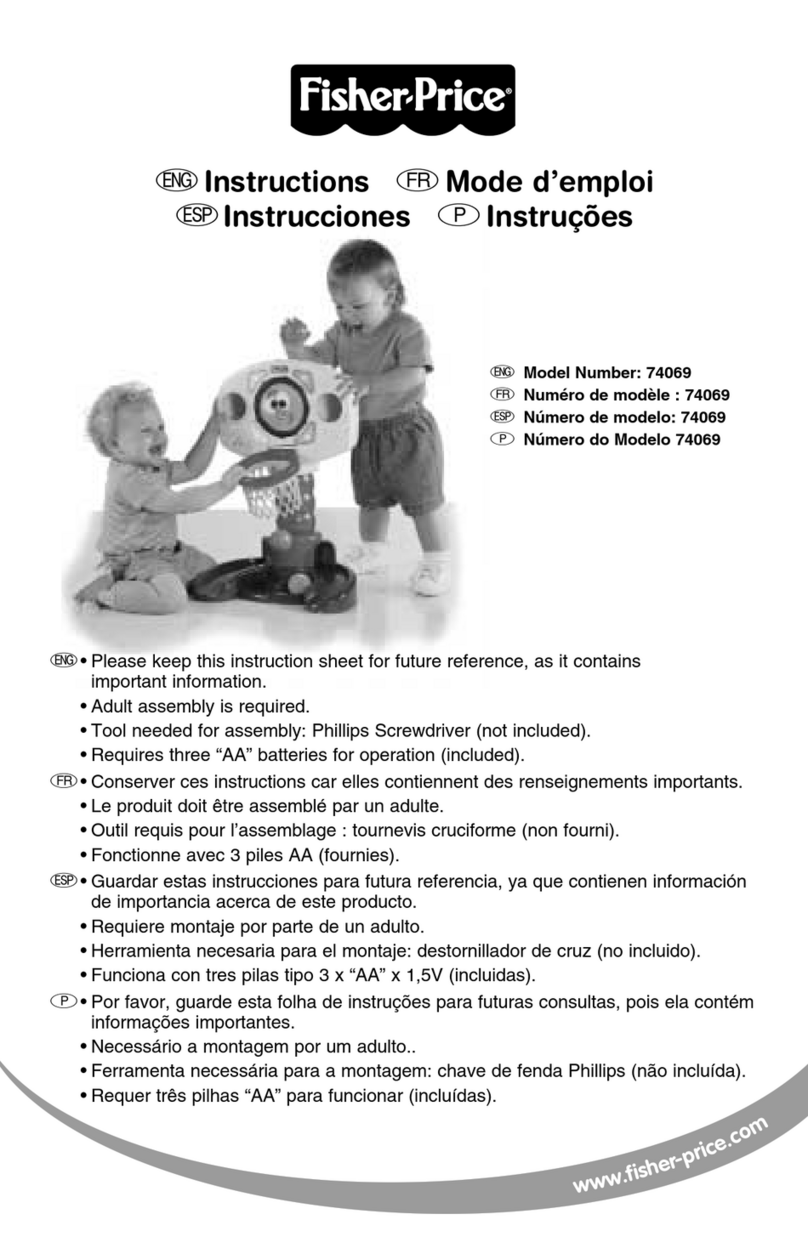
Fisher-Price
Fisher-Price 74069 instructions
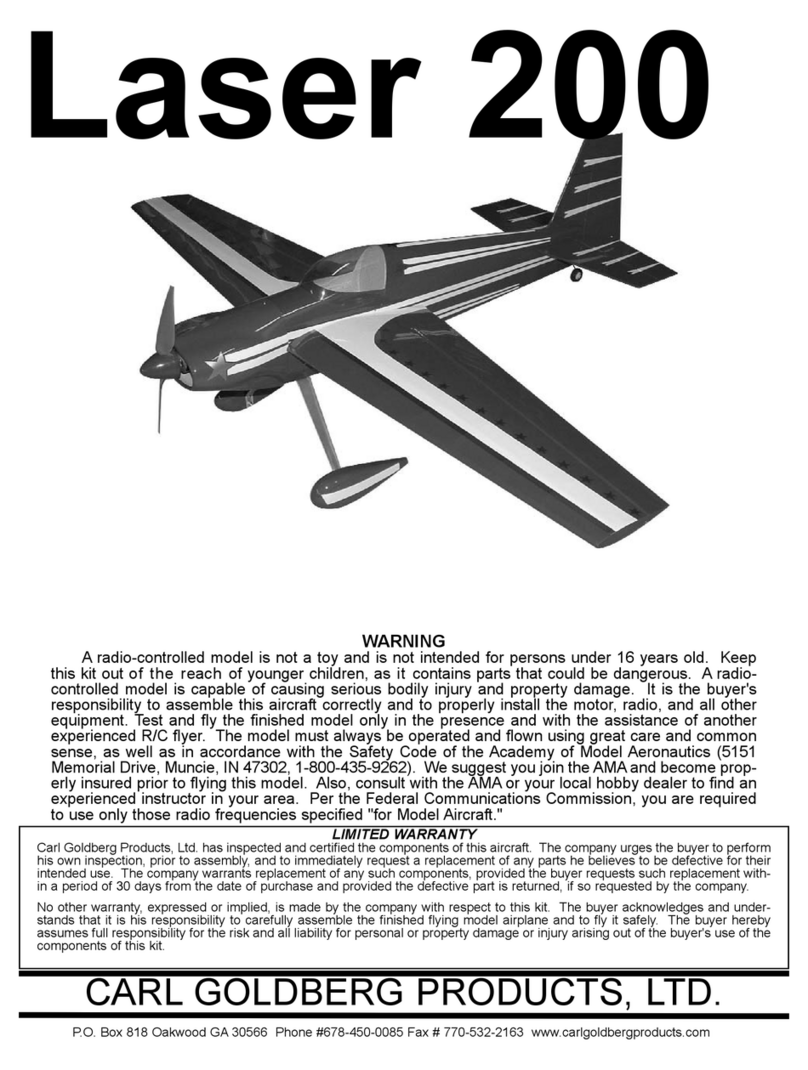
Carl Goldberg Products
Carl Goldberg Products Laser 200 instruction manual

Little Tikes
Little Tikes Junior Ballpit 641800 quick start
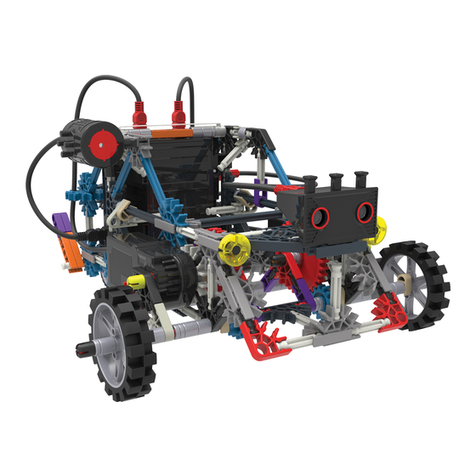
K'Nex Education
K'Nex Education CAR BOT Instruction booklet

Peg-Perego
Peg-Perego Corral T-REX IGOR0058 Use and care
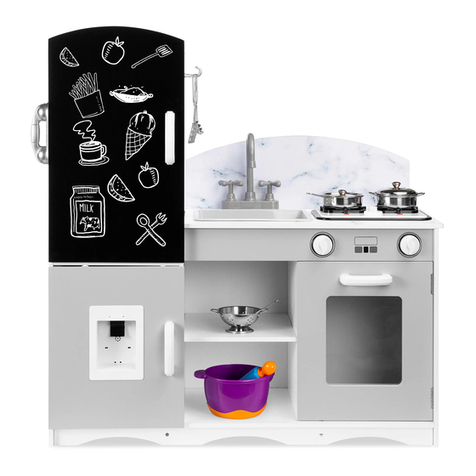
BCP
BCP SKY4954 instruction manual

Mega Construx
Mega Construx Barbie Dreamtopia Seahorse Carousel manual

MTHTrains
MTHTrains 20-5629-1 Operator's manual
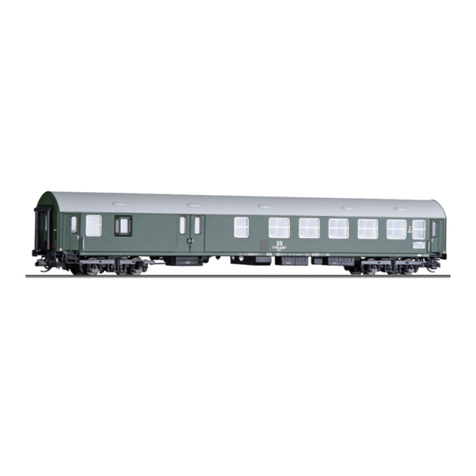
TILLIG BAHN
TILLIG BAHN 01806 manual
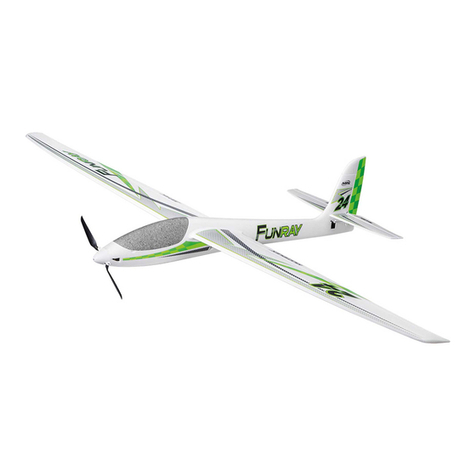
Multiplex
Multiplex Funray manual

Eduard
Eduard Sd.Kfz. 166 Brummbar zimmerit 1/35 quick start guide
Fisher-Price
Fisher-Price JEEP RUBICON H4433 Owner's manual & assembly instructions
